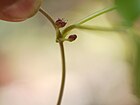Note: This is a project under development. The articles on this wiki are just being initiated and broadly incomplete. You can Help creating new pages.
Centella asiatica - Mandooka Parni
Centella asiatica is a small, herbaceous, frost-tender perennial plant of the family Mackinlayaceae. it is a small creeping herb with shovel shaped leaves emerging alternately in clusters at the stem nodes.
Contents
- 1 Uses
- 2 Parts Used
- 3 Chemical Composition
- 4 Common names
- 5 Properties
- 6 Habit
- 7 Identification
- 8 List of Ayurvedic medicine in which the herb is used
- 9 Where to get the saplings
- 10 Mode of Propagation
- 11 How to plant/cultivate
- 12 Commonly seen growing in areas
- 13 Photo Gallery
- 14 References
- 15 External Links
Uses
Hysteria, Dysuria, Insomnia, Swelling, Chronic ulcers, Cold, Cough, Diarrhea, Asthma[1]
Parts Used
Chemical Composition
Centella asiatica has large amounts of pentacyclic triterpenoids including asiaticoside, brahmoside, asiatic acid, and brahmic acid.[2]
Common names
| Language | Common name |
|---|---|
| Kannada | ಬ್ರಾಹ್ಮಿ ಸೊಪ್ಪು Brahmi soppu, ಗದ್ದೆ ಬರಗ Gadde baraga |
| Hindi | Bheki |
| Malayalam | Kutakam, Kutannal |
| Tamil | Kacappi, Matanti |
| Telugu | Mandukaparni, Sarasvati-aku |
| Marathi | NA |
| Gujarathi | Brahmi, Khadabrahmi |
| Punjabi | NA |
| Kashmiri | NA |
| Sanskrit | Bhandi, Bhandiri |
| English | Pennywort, Coinwort |
Properties
Reference: Dravya - Substance, Rasa - Taste, Guna - Qualities, Veerya - Potency, Vipaka - Post-digesion effect, Karma - Pharmacological activity, Prabhava - Therepeutics.
Dravya
Rasa
Madhura, Katu, Tikta, Kasaya
Guna
Laghu, Sara
Veerya
Shita
Vipaka
Madura
Karma
Balya, Dipana, Hrdya, Kaphapittahara, Medhya, Varnya, Visaghna, Svarya, Rasayana, Ayuṣya, Smrtiprada
Prabhava
Habit
Identification
Leaf
| Kind | Shape | Feature |
|---|---|---|
| Simple | Orbicular-reniform | Crenate or sub-entire, glabrous, nerves radiating, petiole to 12 cm long, sheathing at base |
Flower
| Type | Size | Color and composition | Stamen | More information |
|---|---|---|---|---|
| Unisexual | 1-2 cm long | Pink | 5 | Flowers Season is June - August |
Fruit
| Type | Size | Mass | Appearance | Seeds | More information |
|---|---|---|---|---|---|
| Ovoid | 3-4 mm long | Reticulate-rugose | 7-9-ribbed | Many |
Other features
List of Ayurvedic medicine in which the herb is used
Where to get the saplings
Mode of Propagation
How to plant/cultivate
Centella asiatica, more commonly known as gotu kola, has enjoyed a long history as a medicinal herb in the Orient[6]
Commonly seen growing in areas
Photo Gallery
References
- ↑ Karnataka Medicinal Plants Volume - 2 by Dr.M. R. Gurudeva, Page No. 147
- ↑ Chemistry
- ↑ Common names
- ↑ Kappatagudda - A Repertoire of Medicianal Plants of Gadag by Yashpal Kshirasagar and Sonal Vrishni, Page No. 121
- ↑ Ayurvedic preparations
- ↑ How to cultivate centella
External Links
- Pages using duplicate arguments in template calls
- Ayurvedic Herbs known to be helpful to treat Hysteria
- Ayurvedic Herbs known to be helpful to treat Dysuria
- Ayurvedic Herbs known to be helpful to treat Insomnia
- Ayurvedic Herbs known to be helpful to treat Swelling
- Ayurvedic Herbs known to be helpful to treat Chronic ulcers
- Ayurvedic Herbs known to be helpful to treat Cold
- Ayurvedic Herbs known to be helpful to treat Cough
- Ayurvedic Herbs known to be helpful to treat Diarrhea
- Ayurvedic Herbs known to be helpful to treat Asthma
- Herbs with Leaves used in medicine
- Herbs with Stem used in medicine
- Herbs with Roots used in medicine
- Herbs with common name in Kannada
- Herbs with common name in Hindi
- Herbs with common name in Malayalam
- Herbs with common name in Tamil
- Herbs with common name in Telugu
- Herbs with common name in Gujarathi
- Herbs with common name in Sanskrit
- Herbs with common name in English
- Habit - Evergreen Perennial
- Index of Plants which can be propagated by Seeds
- Index of Plants which can be propagated by Cuttings
- Herbs that are commonly seen in the region of Along ditches
- Herbs that are commonly seen in the region of Wet areas
- Herbs
- Apiaceae





